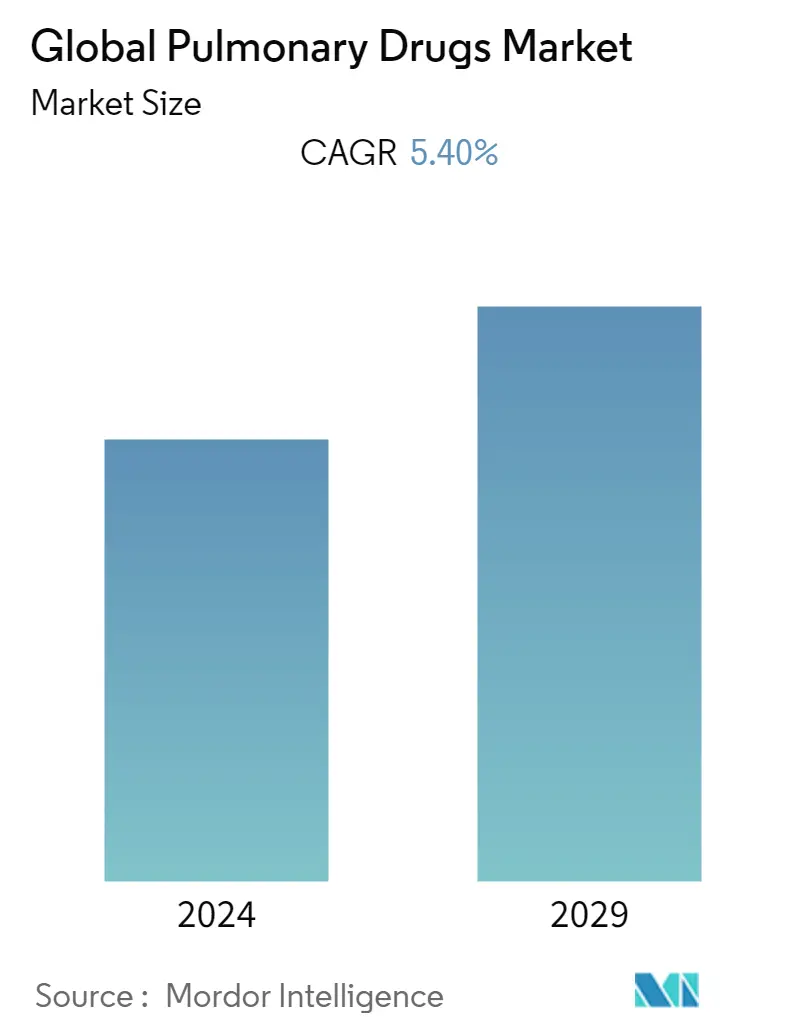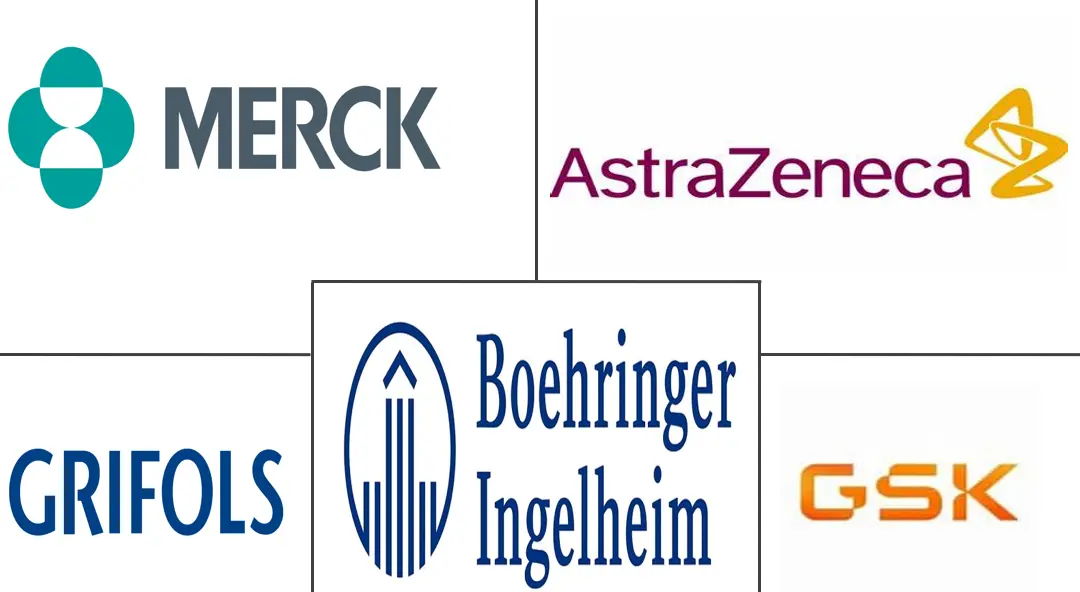Market Size of Global Pulmonary Drugs Industry

| Study Period | 2019 - 2029 |
| Base Year For Estimation | 2023 |
| CAGR | 5.40 % |
| Fastest Growing Market | Asia Pacific |
| Largest Market | North America |
| Market Concentration | Low |
Major Players
*Disclaimer: Major Players sorted in no particular order |
Pulmonary Drugs Market Analysis
The pulmonary drugs market is expected to register a CAGR of 5.4% over the forecast period (2022-2027).
The COVID-19 pandemic and lockdowns in various countries across the world have impacted the financial status of businesses across all sectors, including the private healthcare sector. The COVID-19 pandemic has impacted the entire supply chain of the healthcare industry, owing to the strict lockdown in several regions. Private healthcare is one such sector that has been impacted significantly by the COVID-19 pandemic.
However, the COVID-19 pandemic had a positive impact on the global pulmonary drugs market, due to patients with asthma and Chronic Obstructive Pulmonary Disease (COPD) being considered at increased risk of death from Covid-19. For instance, in August 2021, according to data published by National Center for Biotechnology Information, Asthma statistics worldwide for 2020 showed that more than 339 million individuals have asthma and that around four million children develop asthma each year on a global level. Thus, increasing cases of COVID-19 are rising the cases of respiratory disorders which generates the need for pulmonary drugs.
Additionally, various clinical research studies based on SARS-CoV-2 showcased that the virus is capable of changing pulmonary hemodynamics through the mechanisms of venous thromboembolism, endothelial dysfunction, thrombotic microangiopathy, and vascular leak. For instance, In January 2021, the National Center for Biotechnology Information (NCBI) published a study that states that those patients who died of COVID-19, exhibited thickened pulmonary vascular walls. This shows that in the future, SARS-CoV-2 can trigger the high susceptibility of infected individuals to developing pulmonary arterial hypertension. Thus, COVID-19 has a significant impact on market growth.
Certain factors that are driving the market growth include the rising prevalence of pulmonary diseases and the growing geriatric population. Pulmonary diseases affect the airways and other parts of the lungs for a long duration of the period. Respiratory symptoms are among the major causes of consultation with doctors and physicians in primary health care centers. Some of the major preventable chronic respiratory disorders are asthma, chronic obstructive pulmonary disease (COPD), allergic rhinitis, sleep apnea, and tuberculosis (principally, multi-drug resistant tuberculosis). As per the Asthma and allergy foundation of America published in March 2021, Roughly 1 in 13 Americans have asthma, which is about 25 million people. Asthma is one of the largest contributors to this figure, affecting children, adults, and elderly people. The same source stated that about 5 million American children have asthma. There is a high prevalence of severe asthma in the Middle East & Africa and the Latin America region as compared to the mid-range of prevalence in North America, Europe, and Asia-Pacific countries.
Another reason for the increased prevalence of respiratory diseases is the excessive environmental pollution in metropolitan cities and industrial lands. In addition, secondhand smoke exposure also leads to serious respiratory diseases. Stringent government regulations for product approval and side effects associated with drugs are hampering the growth of the market.
Pulmonary Drugs Industry Segmentation
As per the scope of the report, pulmonary diseases refer to the types of diseases that affect the lungs and other parts of the respiratory system. Pulmonary diseases may be caused by infection, by smoking tobacco, or by breathing in secondhand tobacco smoke, radon, asbestos, or other forms of air pollution. Pulmonary drugs are the branch of medicine that deals with the causes, diagnosis, prevention, and treatment of such pulmonary diseases. The Pulmonary Drugs Market is segmented by Drug Class (Beta-2 Agonists, Anticholinergic Agents, Oral and Inhaled Corticosteroids, Anti-leukotrienes, Antihistamines, Monoclonal Antibodies, Combination Drugs, and others), Indication (Asthma, COPD (Chronic Obstructive Pulmonary Disease), Allergic Rhinitis, Pulmonary Arterial Hypertension, Cystic Fibrosis, and Others), Distribution Channel (Hospital Pharmacies, Retail Pharmacies, and others), and Geography (North America, Europe, Asia-Pacific, Middle East and Africa, and South America). The market report also covers the estimated market sizes and trends for 17 different countries across major regions, globally. The report offers the value (in USD million) for the above segments.
| By Drug Class | |
| Beta-2 Agonists | |
| Anti-cholinergic Agents | |
| Oral and Inhaled Corticosteroids | |
| Anti-leukotrienes | |
| Antihistamines | |
| Monoclonal Antibodies | |
| Combination Drugs | |
| Others |
| By Indication | |
| Asthma | |
| COPD (Chronic Obstructive Pulmonary Disease) | |
| Allergic Rhinitis | |
| Pulmonary Arterial Hypertension | |
| Cystic Fibrosis | |
| Others |
| By Distribution Channel | |
| Hospital Pharmacies | |
| Retail Pharmacies | |
| Others |
| Geography | ||||||||
| ||||||||
| ||||||||
| ||||||||
| ||||||||
|
Global Pulmonary Drugs Market Size Summary
The pulmonary drugs market is poised for significant growth, driven by the increasing prevalence of respiratory diseases and a rising geriatric population. The market has been positively influenced by the COVID-19 pandemic, which highlighted the vulnerability of individuals with asthma and Chronic Obstructive Pulmonary Disease (COPD), thereby boosting the demand for pulmonary medications. The pandemic also underscored the potential long-term pulmonary complications associated with SARS-CoV-2, such as pulmonary arterial hypertension, further propelling market expansion. Environmental factors, including pollution and secondhand smoke, have contributed to the rising incidence of respiratory disorders, necessitating the use of pulmonary drugs. Despite challenges such as stringent regulatory requirements and drug side effects, the market is expected to benefit from technological advancements and the development of novel targeted therapies.
The competitive landscape of the global pulmonary drugs market is characterized by the presence of major pharmaceutical players like AstraZeneca, Boehringer Ingelheim, and Merck & Co., among others. These companies are actively engaged in strategic initiatives such as product launches, collaborations, and clinical trials to enhance their market share. The market's growth is further supported by increased health expenditure, government and non-government initiatives, and advanced healthcare infrastructure. Research and development activities aimed at discovering new treatments for respiratory diseases are also contributing to market dynamics. As the market continues to evolve, the focus on innovative therapies and the management of chronic respiratory conditions is expected to drive sustained growth over the forecast period.
Global Pulmonary Drugs Market Size - Table of Contents
-
1. MARKET DYNAMICS
-
1.1 Market Overview
-
1.2 Market Drivers
-
1.2.1 Rising Prevalence of Pulmonary Diseases
-
1.2.2 Increasing Burden of Geriatric Population
-
-
1.3 Market Restraints
-
1.3.1 Stringent Government Regulations for Product Approval
-
1.3.2 Side Effects Associated With Drugs
-
-
1.4 Porter's Five Force Analysis
-
1.4.1 Threat of New Entrants
-
1.4.2 Bargaining Power of Buyers/Consumers
-
1.4.3 Bargaining Power of Suppliers
-
1.4.4 Threat of Substitute Products
-
1.4.5 Intensity of Competitive Rivalry
-
-
-
2. MARKET SEGMENTATION (Market Size by Value - USD million)
-
2.1 By Drug Class
-
2.1.1 Beta-2 Agonists
-
2.1.2 Anti-cholinergic Agents
-
2.1.3 Oral and Inhaled Corticosteroids
-
2.1.4 Anti-leukotrienes
-
2.1.5 Antihistamines
-
2.1.6 Monoclonal Antibodies
-
2.1.7 Combination Drugs
-
2.1.8 Others
-
-
2.2 By Indication
-
2.2.1 Asthma
-
2.2.2 COPD (Chronic Obstructive Pulmonary Disease)
-
2.2.3 Allergic Rhinitis
-
2.2.4 Pulmonary Arterial Hypertension
-
2.2.5 Cystic Fibrosis
-
2.2.6 Others
-
-
2.3 By Distribution Channel
-
2.3.1 Hospital Pharmacies
-
2.3.2 Retail Pharmacies
-
2.3.3 Others
-
-
2.4 Geography
-
2.4.1 North America
-
2.4.1.1 United States
-
2.4.1.2 Canada
-
2.4.1.3 Mexico
-
-
2.4.2 Europe
-
2.4.2.1 Germany
-
2.4.2.2 United Kingdom
-
2.4.2.3 France
-
2.4.2.4 Italy
-
2.4.2.5 Spain
-
2.4.2.6 Rest of Europe
-
-
2.4.3 Asia Pacific
-
2.4.3.1 China
-
2.4.3.2 Japan
-
2.4.3.3 India
-
2.4.3.4 Australia
-
2.4.3.5 South Korea
-
2.4.3.6 Rest of Asia-Pacific
-
-
2.4.4 Middle East and Africa
-
2.4.4.1 GCC
-
2.4.4.2 South Africa
-
2.4.4.3 Rest of Middle East and Africa
-
-
2.4.5 South America
-
2.4.5.1 Brazil
-
2.4.5.2 Argentina
-
2.4.5.3 Rest of South America
-
-
-
Global Pulmonary Drugs Market Size FAQs
What is the current Global Pulmonary Drugs Market size?
The Global Pulmonary Drugs Market is projected to register a CAGR of 5.40% during the forecast period (2024-2029)
Who are the key players in Global Pulmonary Drugs Market?
Boehringer Ingelheim, Merck & Co., AstraZeneca PLC, GlaxoSmithKline PLC and Grifols, S.A. are the major companies operating in the Global Pulmonary Drugs Market.

